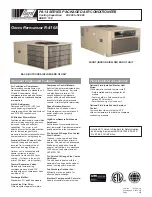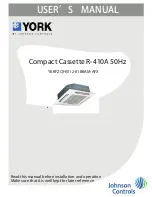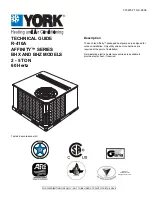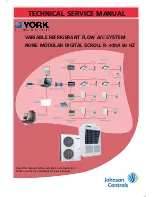
12
7. Electrical work
7.2. Branch box/outdoor wire connection and outdoor power supply cord connection
Warning:
•
Be sure to attach the terminal block covers/panel of the outdoor unit securely. If it is not attached correctly, it could result in a fire or an electric shock due to
dust, water, etc.
•
Be sure to connect the power supply cords and the connecting wires for the indoor units, outdoor units, and branch boxes directly to the units (no intermediate
connections).
Intermediate connections can lead to communication errors if water enters the cords or wires and causes insufficient insulation to ground or a poor electrical
contact at the intermediate connection point.
(If an intermediate connection is necessary, be sure to take measures to prevent water from entering the cords and wires.)
Caution:
• Be careful not to make mis-wiring.
• Firmly tighten the terminal screws to prevent them from loosening.
• After tightening, pull the wires lightly to confirm that they not move.
• If the connecting wire is incorrectly connected to the terminal block, the unit does not operate normally.
• Be sure to install N-line. Without N-line, it could cause damage to the unit.
• Connect wire from the branch box correctly to the terminal block.
• For future servicing, give extra length to connecting wire.
Terminal
block
Loosen terminal screw.
Lead wire
Connection details
7.3. External wiring procedure (Fig. 7-2)
The power supply work is needed only to the outdoor unit. The power supply to the branch box or indoor unit is conducted through wiring.
Therefore, the power supply work can be carried out at just one spot of the outdoor unit. It will contribute to simplify the work and save costs.
Power supply
Model
Power supply
140-160V
~ /N 220/ 230/ 240V 50Hz , ~ /N 220V 60Hz
140-160Y
3N~ 380/ 400/ 415V 50Hz
Max. Permissive System Impedance 0.22(
Ω
)
Note:
Power supply input: Outdoor unit only.
Connect the lines (C), (D) in accordance with the terminal block names to ensure correct polarity.
Model
Wire diameter
Breaker *1
(A) Main power line
(B) Earth line
(C) Signal line
(D) Signal line
Interrupting current
Performance characteristic
140-160V
6.0 mm
2
6.0 mm
2
1.5 mm
2
*2
1.5 mm
2
40 A
40A, 30 mA
for 0.1 sec. or less
140-160Y
1.5 mm
2
1.5 mm
2
1.5 mm
2
*2
1.5 mm
2
25 A
25A, 30 mA
for 0.1 sec. or less
When using twisted wire for the wiring, the use of round terminal is required.
*1. A breaker with at least 3 mm contact separation in each pole shall be provided. Use earth leakage breaker (NV).
*2. Max. 45 m (“Outdoor unit - Branch box
#
1” plus “Branch box
#
1 - Branch box
#
2”).
If 2.5 mm
2
used, Max. 55 m.
Notes: 1. Wiring size must comply with the applicable local and national code.
2.
Power supply cords and Indoor unit/branch box/outdoor unit connecting cords shall not be lighter than polychloroprene sheathed flexible cord.
(Design 60245 IEC 57)
3. Install an earth line longer than power cables.
IMPORTANT
Make sure that the current leakage breaker is one compatible with higher harmonics.
Always use a current leakage breaker that is compatible with higher harmonics as this unit is equipped with an inverter.
The use of an inadequate breaker can cause the incorrect operation of inverter.
7.1. Outdoor unit (Fig. 7-1)
Remove the service panel.
Wire the cables referring to the Fig. 7-1.
Earth terminal
Terminal block
Clamp
Service panel
Wire the cables so that they do not contact the center of the service panel or the gas
valve.
Fig. 7-1
L
N
S1 S2 S3
■ 8B140,160V
■ 8B140,160Y
L1 L2 L3 N
S 1 S 2 S 3
Summary of Contents for MXZ-8B140
Page 16: ......




































